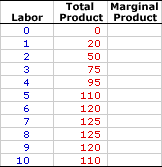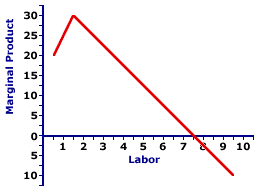
|
|
LIQUIDITY: The ease of converting an asset into money (either checking accounts or currency) in a timely fashion with little or no loss in value. Money is the standard for liquidity because it is, well, money and no conversion is needed. Other assets, both financial and physical have varying degrees of liquidity. Savings accounts, certificates of deposit, and money market accounts are highly liquid. Stocks, bonds, and are another step down in liquidity. While they can be "cashed in," price fluctuations, brokerage fees, and assorted transactions expenses tend to reduce their money value. Physical assets, like houses, cars, furniture, clothing, food, and the like have substantially less liquidity.
Visit the GLOSS*arama
|
|


|

|
                           MARGINAL PRODUCT: The change in the quantity of total product resulting from a unit change in a variable input, keeping all other inputs unchanged. Marginal product, usually abbreviated MP, is found by dividing the change in total product by the change in the variable input. Marginal product, which occasionally goes by the alias marginal physical product (MPP), is one of two measures derived from total product. The other is average product. Marginal product is the extra output generated by an extra input. Marginal product lies at the very foundation of the analysis of short-run production, playing THE critical role in the explanation of the law of supply and the upward-sloping supply curve using the law of diminishing marginal returns. Of the myriad of short-run production-related terms (including total product, average product, fixed input, variable input, short run, long run) marginal product is by far the most important.The formula for specifying and calculating marginal product from total product is given as: | marginal product | = | change in total product
change in variable input |
The proper economic interpretation of marginal product is as the contribution of the last unit of variable input to total production. That is, how much does total product change by adding the last unit? If, for example, the marginal product of labor is 25 tacos, then this means that employing the last worker causes total product to increase by 25 tacos. Does this mean the last worker personally produces 25 tacos? No, not at all. Or at least, not necessarily. It means that having this person employed by the firm causes total product to increase by 25 tacos. More often that not, this added worker makes existing workers more productive. Marginal Taco ProductionThe table at the right summarizes the hourly production by Waldo's TexMex Taco World of Super Deluxe TexMex Gargantuan Tacos (with sour cream and jalapeno peppers). The total product numbers presented can be used to derive the marginal product.| Marginal Taco Product |  |
The column on the left is the variable input, specifically the number of workers employed by Waldo's TexMex Taco World, which ranges from 0 to 10. The center column is the total product, the total number of TexMex Gargantuan Tacos produced each hour, which ranges from a low of 0 to a high of 125 before declining to 110. Keep in mind that the taco production from these workers depends on a given amount of fixed inputs, Waldo's TexMex Taco World restaurant and all of the capital that goes with it.Missing from this table is any mention of marginal product. This apparent oversight can be rectified with a few button clicks. - First, consider this question: What is the contribution of the first worker to total Gargantuan Taco production? Or put another way: What is the change in total product resulting from a change in the variable input?
To answer these questions, note that total hourly Gargantuan Taco production with zero workers is also zero. No input, no output. But with one worker busily making Gargantuan Tacos, the hourly taco production increases to 20. The change in total product resulting from the employment of the first worker is 20. Click the [First] button to verify that the marginal product of the first worker is 20 tacos.
- How about the marginal product of the second worker? A click of the [Second] button reveals that employing the second worker adds 30 Gargantuan Tacos to the hourly taco production of Waldo's TexMex Taco World. This number is found by taking the difference between total hourly taco production with one worker (20 Gargantuan Tacos) and the total hourly taco production with two workers (50 Gargantuan Tacos).
- Now consider the marginal product of the third worker. Adding a third worker boosts total hourly taco production from the 50 Gargantuan Tacos produced by two workers to 75 Gargantuan Tacos produced by three workers. This means that the marginal product of the third worker is 25 Gargantuan Tacos.
To display marginal products associated with the addition of the remaining workers, click the [Others] button.What interesting and useful information can be derived from this expanded table? - First, the marginal product of workers increases for the first two workers, reaching a peak of 30 Gargantuan Tacos, then declines thereafter. The increasing marginal product observed for the first few workers illustrates increasing marginal returns and the decreasing marginal product observed for all subsequent workers illustrates decreasing marginal returns. Moreover, the decreasing marginal products is attributable to the law of diminishing marginal returns, THE key principle underlying the study of short-run production.
- Second, notice that marginal product decreases so much that it becomes zero for the eighth worker and even becomes negative for the ninth and tenth workers. The zero value of marginal product for the eighth worker also occurs where the total product has reached its maximum value. Coincidence? Not at all. The peak of the total product curve has a zero slope. Marginal product is another term for the slope of the total product curve.
The Marginal Product Curve| Marginal Product Curve |  |
The marginal product curve is a graphical representation of the relation between marginal product and the variable input. The marginal product curve for Gargantuan Taco production is displayed to the right.The "general" slope of this curve is negative, with incremental output declining for larger workforces. However, the marginal product curve is actually "hump" shaped, with a positive slope giving way to a negative slope. Consistent with the numbers in the table, the curve reaches a peak of 30 Gargantuan Tacos for the second worker. Total and AverageTwo related product measures are total product and average product.- Total Product: This is the total quantity of output produced by a firm for a given quantity of inputs. Total product is the foundation upon which the analysis of short-run production for a firm is based. It also provides the basis for calculating marginal product.
- Average Product: This is the amount of output produced per worker, found by dividing the total product by the number of workers. If, for example, Waldo's TexMex Taco World has a staff of 5 that generates a total product of 110 tacos, then average product is 22 tacos.

Recommended Citation:MARGINAL PRODUCT, AmosWEB Encyclonomic WEB*pedia, http://www.AmosWEB.com, AmosWEB LLC, 2000-2024. [Accessed: May 18, 2024].
Check Out These Related Terms... | | | | | | | | | |
Or For A Little Background... | | | | | | | | | | | | | |
And For Further Study... | | | | | | | | | | |
Search Again?
Back to the WEB*pedia
|



|

|
YELLOW CHIPPEROON
[What's This?]
Today, you are likely to spend a great deal of time watching the shopping channel wanting to buy either a rechargeable battery for your computer or shoe laces for your snow boots. Be on the lookout for letters from the Internal Revenue Service.
Your Complete Scope
This isn't me! What am I?
|

|
|
More money is spent on gardening than on any other hobby.
|

|
|
"Perhaps the most valuable result of all education is the ability to make yourself do the thing you have to do, when it ought to be done, whether you like it or not; it is the first lesson that ought to be learned; and however early a man's training begins, it is probably the last lesson that he learns thoroughly. " -- Thomas H. Huxley, Scientist
|

|
EMU
European Monetary Union
|

|
|
Tell us what you think about AmosWEB. Like what you see? Have suggestions for improvements? Let us know. Click the User Feedback link.
User Feedback
|


|


